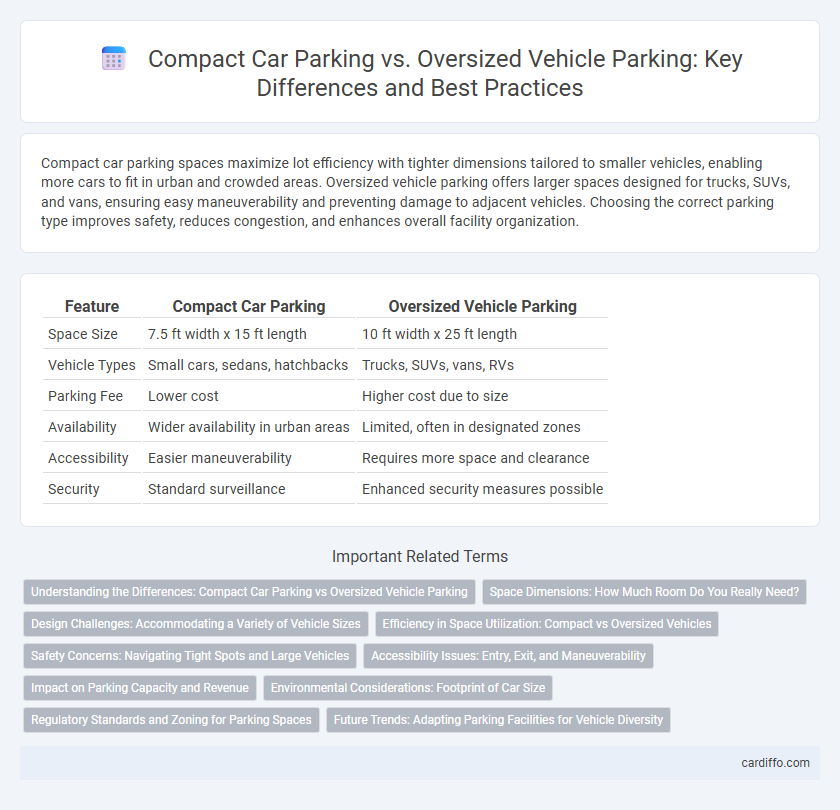Compact car parking spaces maximize lot efficiency with tighter dimensions tailored to smaller vehicles, enabling more cars to fit in urban and crowded areas. Oversized vehicle parking offers larger spaces designed for trucks, SUVs, and vans, ensuring easy maneuverability and preventing damage to adjacent vehicles. Choosing the correct parking type improves safety, reduces congestion, and enhances overall facility organization.
Table of Comparison
| Feature | Compact Car Parking | Oversized Vehicle Parking |
|---|---|---|
| Space Size | 7.5 ft width x 15 ft length | 10 ft width x 25 ft length |
| Vehicle Types | Small cars, sedans, hatchbacks | Trucks, SUVs, vans, RVs |
| Parking Fee | Lower cost | Higher cost due to size |
| Availability | Wider availability in urban areas | Limited, often in designated zones |
| Accessibility | Easier maneuverability | Requires more space and clearance |
| Security | Standard surveillance | Enhanced security measures possible |
Understanding the Differences: Compact Car Parking vs Oversized Vehicle Parking
Compact car parking spaces are designed with narrower widths and shorter lengths, typically around 7.5 to 8 feet wide and 15 to 16 feet long, to maximize lot capacity and efficiently accommodate smaller vehicles. Oversized vehicle parking spaces offer increased dimensions, often exceeding 10 feet in width and 20 feet in length, to safely accommodate trucks, SUVs, and vans, ensuring proper clearance and maneuverability. Understanding these size requirements prevents vehicle damage, optimizes lot utilization, and improves overall parking safety and accessibility.
Space Dimensions: How Much Room Do You Really Need?
Compact car parking spaces typically measure around 7.5 to 8 feet in width and 15 to 16 feet in length, providing just enough room for smaller vehicles without excess space. Oversized vehicle parking requires significantly larger dimensions, often exceeding 9 feet in width and 20 feet in length, to accommodate trucks, SUVs, and vans comfortably. Understanding these space dimensions ensures efficient lot design and optimal utilization of parking areas for different vehicle types.
Design Challenges: Accommodating a Variety of Vehicle Sizes
Designing parking facilities that accommodate both compact cars and oversized vehicles requires balancing space efficiency with accessibility. Compact car parking spaces are typically narrower and shorter, maximizing the number of spots available, while oversized vehicle parking must provide extra width and length to safely house SUVs, trucks, and vans without risking damage. Integrating varied space dimensions, clear signage, and strategic layout planning addresses challenges related to vehicle maneuverability and optimizes overall parking lot functionality.
Efficiency in Space Utilization: Compact vs Oversized Vehicles
Compact car parking maximizes efficiency by allowing more vehicles to fit within a given area due to smaller dimensions, reducing wasted space between spots. Oversized vehicle parking requires broader spaces to accommodate larger dimensions and turning radii, which significantly decreases the total number of vehicles that can be parked. Optimizing space utilization involves balancing the demand for compact and oversized parking to enhance overall lot capacity and accessibility.
Safety Concerns: Navigating Tight Spots and Large Vehicles
Compact car parking offers tighter spaces that reduce the risk of collisions with larger vehicles but require careful maneuvering to avoid scrapes and dents. Oversized vehicle parking accommodates buses, trucks, and RVs with more room, minimizing the risk of damage but often leading to limited visibility and blind spots. Safety concerns highlight the importance of designed parking zones tailored to vehicle size, enhancing overall parking lot security and reducing accident potential.
Accessibility Issues: Entry, Exit, and Maneuverability
Compact car parking offers increased maneuverability with narrower spaces designed for smaller vehicles, facilitating easier entry and exit in tight urban environments. Oversized vehicle parking, while accommodating larger dimensions, often presents challenges such as limited availability and restricted turning radii that complicate smooth access. Accessibility issues in either type emphasize the need for well-designed parking layouts to minimize congestion and ensure safe vehicle movement.
Impact on Parking Capacity and Revenue
Compact car parking spaces increase overall parking capacity by fitting more vehicles into a given area compared to oversized vehicle parking, which requires larger spaces and reduces the total number of spots. Higher parking capacity directly boosts revenue potential through increased turnover and space utilization efficiency. Facilities that allocate more spaces for compact cars can maximize income by targeting urban drivers and encouraging shorter stays, while oversized vehicle parking caters to niche markets but limits capacity and revenue growth.
Environmental Considerations: Footprint of Car Size
Compact car parking significantly reduces environmental impact by minimizing land use and preserving green spaces compared to oversized vehicle parking, which demands larger spaces and contributes to increased surface runoff and heat islands. Efficient compact car spaces enhance urban sustainability through decreased resource consumption for paving and maintenance, supporting better stormwater management. Prioritizing compact vehicle parking aligns with eco-friendly urban planning by lowering the overall carbon footprint associated with parking infrastructure.
Regulatory Standards and Zoning for Parking Spaces
Regulatory standards for compact car parking typically require space widths between 7.5 to 8.5 feet and lengths of 15 to 18 feet, ensuring efficient use of urban areas. Oversized vehicle parking mandates larger dimensions, often exceeding 10 feet in width and 20 feet in length, to accommodate trucks, SUVs, and vans, complying with local zoning laws that restrict oversized vehicle parking in residential zones. Zoning regulations frequently designate specific areas or lot sections for oversized vehicles, balancing accessibility with neighborhood aesthetics and safety requirements.
Future Trends: Adapting Parking Facilities for Vehicle Diversity
Future parking facilities will increasingly incorporate adaptive designs to accommodate both compact cars and oversized vehicles, addressing growing vehicle diversity. Innovations like modular parking spaces, dynamic allocation systems, and sensor-based monitoring will optimize space utilization and enhance user experience. Emphasizing sustainability, electric vehicle charging stations and smart technology integration will become standard features in next-generation parking infrastructures.
Compact Car Parking vs Oversized Vehicle Parking Infographic

 cardiffo.com
cardiffo.com